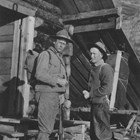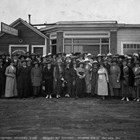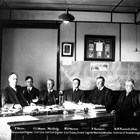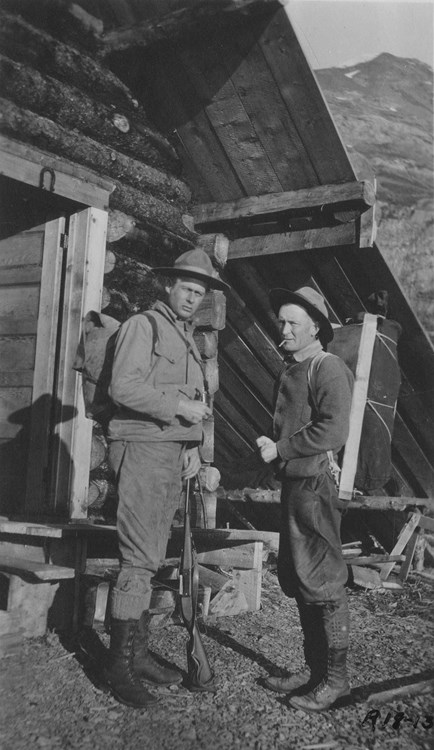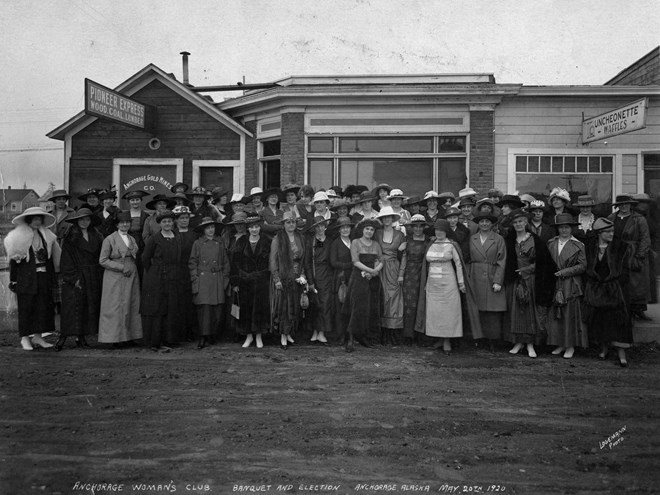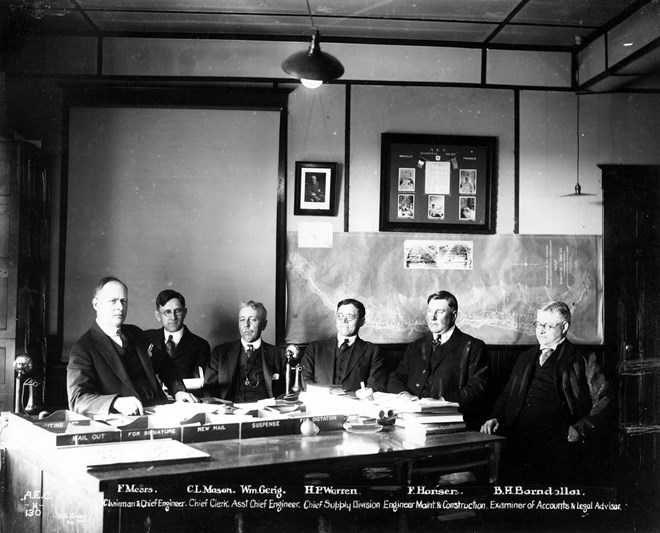Mears, Frederick
1878-1939 | Chief Engineer and Member (later Chairman), Alaskan Engineering Commission, U.S. Army Officer
Colonel Frederick Mears was the chief engineer and member of the Alaskan Engineering Commission (AEC), the builder of the Alaska Railroad and the original operator, from 1914 to 1923. In 1919, he was appointed as chairman of the AEC to replace William C. Edes. The Alaska Railroad was built at a cost of $56 million over a period of eight years (1914-1923).
Frederick Mears was born on May 25, 1878 into a military family toward the end of the United States’ Indian Wars of the post-Civil War period. His father, Frederick J. Mears, was a career Army cavalry officer, and the Mears family lived in a succession of military posts in the American West. As a youth Frederick Mears distinguished himself at the Shattuck Military School in Faribault, Minnesota, where he graduated with honors in 1897. It was the same institution his father had attended and it modeled its academic program after the U.S. Military Academy at West Point (with required classes in Greek, Latin, civil government, trigonometry, quantitative analysis, and mechanical drawing, in addition to basic courses, at the high school level).1 From time to time, he was invited to stay with a fellow student and his best friend, Donald Stevens, and Mears grew enamored with engineering and railroading during visits to the Stevens home. At age nineteen, Mears went to work for the senior Stevens, civil engineer and railroad executive John F. Stevens of the Great Northern Railway, who became Mears’ mentor. Mears was hired as a laborer to work on a survey party in Minnesota. As he proved his capability, Mears rapidly advanced within the organization, becoming the chief resident engineer within two years on one of the Great Northern’s branch lines in British Columbia.2
Military Service and Work with Isthmian Canal Commission (1899-1914)
In the fall of 1899 Mears enlisted as a private in the U.S. Army during the Philippine Insurrection (1899-1902), joining Company K of the Third Infantry, known as the Old Guard. On January 30, 1900, the entire company of 106 men sailed to join the campaign against Filipino revolutionary leader Emilio Aguinaldo. He was quickly promoted to the rank of sergeant, and then earned a commission as a second lieutenant in 1901. Remaining in the military as a cavalryman, Mears took advanced engineering courses at the U.S. Infantry and Calvary School at Fort Leavenworth, Kansas, graduating with distinction in 1904. He then went on to complete two more years of advanced study at the nearby Staff College.
In late 1905, John F. Stevens, then chief engineer for the Isthmian Canal Commission, the U.S. government agency which was building the Panama Canal, requested Mears to work as an engineer on that project. In February 1907, Stevens abruptly resigned, emphasizing that the Panama Canal project required the expertise of a hydraulic engineer. George W. Goethals, a colonel in the U.S. Army Corps of Engineers, was chosen as Stevens’s successor in Panama. He was appointed as both chairman and chief engineer of the Isthmian Canal Commission in March 1907.
By 1909, in spite of his low military rank, Lieutenant Mears had assumed greater and greater responsibilities in Panama. Mears first served as the track foreman in 1906 at the Culebra Cut. In September 1906, Mears was appointed as assistant engineer for the Panama Canal Railroad relocation project under Ralph Budd, the engineer in charge of construction. In 1907, Mears received a promotion to first lieutenant. In 1909, Mears succeeded Budd as chief engineer of the Panama Railroad. He served in that capacity until 1914, when he was promoted to general superintendent of the Panama Railroad and of the Panana Canal Company’s steamship line, in addition to his responsibilities as chief engineer. The Panama Railroad Company was a $5 million engineering and construction project which in turn supported the Panama Canal construction. His duties eventually included supervising the operation of six steamships which brought supplies for the construction projects from the United States.
As the Panama Canal construction was being completed in 1913-1914, President Woodrow Wilson advocated the construction of a railroad or railroads in Alaska to provide access to the territory’s resources. President Wilson saw the venture as the key to unlocking the territory’s storehouse of coal and other minerals. In his State of the Union address on December 2, 1913, he declared that “We must use the resources of this country, not lock them up.”3
With a proposed budget of $35 million, the northern work was to be supervised by a commission based on the Isthmian Canal Commission which had supervised the Panama Canal construction. Called to Washington to advise President Wilson and Secretary of the Interior Franklin K. Lane on the new project, Goethals strongly recommended Mears to be one of the three members of the Alaskan Engineering Commission (AEC) on the basis of his experience as an engineer and administrator, and because of his experience building railroads.4 President Wilson appointed Mears to the AEC in April 1914. As a junior cavalry officer, it took a special joint resolution of Congress to confirm his position that had been set aside for the Corps of Engineers.5
In spring 1914, Mears was on his way to Alaska to supervise eleven surveying crews who were mapping out possible routes for the proposed railroad, which was to run from the Pacific Ocean to deep in Alaska’s interior. There were only two choices, as there were only two portals through the Coast Mountains—the Copper River and the “western” or Seward-Fairbanks route over the Kenai Peninsula and north of the lower Susitna Valley. The Alaska Syndicate’s “eastern” route went up the Copper River from Cordova and the corporation hoped to sell the railroad to the government. This deal was politically impossible as the price offered was too high and it would have raised the spectre of collusion between the government and the Guggenheim Corporation.6 Of the two possible routes, Wilson chose the Seward-Fairbanks route starting at Seward and utilizing the right of way of the Alaska Northern Railroad, which had laid track from Seward to the head of Turnagain Arm, and that of the Tanana Valley Railroad in the interior. Construction began in the summer of 1915.
On returning to Alaska to begin the project in 1915, Mears was surprised to find over two thousand job applicants or merchants camped on the Ship Creek flats near the north end of Cook Inlet, land on which he had planned to build workshops and warehouses for the operation of the railroad. One of AEC’s first tasks was to create a townsite and to design and build the port there. The U.S. General Land Office, which had authority to dispose of the land around Ship Creek, quickly had the area that became Anchorage surveyed, cleared, platted and then auctioned off, and people moved off the flats so that railroad construction could begin. The AEC found itself assuming many of the responsibilities of a local government, building roads, water and sewer lines, and providing electrical power and telephone service.
Mears was in charge of the central section of the proposed railroad, charged with building a railroad from the end of the Alaska Northern’s track at the head of Turnagain Arm to Broad Pass, a distance of two hundred miles through wilderness. In addition he was to build a 38-mile spur line to the coal fields at Matanuska. To do this Mears and the other commissioners chose to build a dock and infrastructure at Ship Creek, now Anchorage. In the fall of 1916 Mears was promoted to the rank of captain in the U.S. Army. By the time the United States entered World War I in April 1917, over five thousand men were employed in various capacities in the construction of the Alaska Railroad.
World War I saw Mears promoted to major and then colonel to command the 31st Railway Engineers regiment, one of nine U.S. Army regiments sent to operate military railroads in France. After demonstrating his administrative competence, Mears was promoted to be general manager of all the U.S. Army’s military trains, a post he held until May 1919. In recognition of his services he received the U.S. Distinguished Service Medal and the Grand Cross of the French Legion of Honor.
After World War I, Secretary of the Interior Lane requested that Mears be released from his military duties to again be a driving force in the construction of the Alaska Railroad. During the war, the work force had dwindled to less than 2,550 as men enlisted or took jobs in the Lower 48. Still, work had continued. The other two AEC commissioners had left, William C. Edes to retirement and Thomas Riggs to become governor of Alaska. Mears was appointed chairman of the AEC and also its chief engineer. He was now fully in charge of the Alaska Railroad’s construction. The original $35 million had been spent; an additional $17 million was appropriated by Congress for construction through 1921, with the admonition to continue the work as economically as possible. During these last years of construction Mears planned and had built four major bridges: over the Susitna River, over the Tanana River, over Riley Creek and the dramatic bridge built over Hurricane Gulch. These were completed by the end of 1922. The last major task was to upgrade the Tanana Valley Railroad from a narrow gauge to a standard gauge track, which was done in 1923. In the summer of 1923 President Warren G. Harding, whose administration was staggered by allegations of corruption, came north to drive the last spike and officially open the Alaska Railroad.
Mears did not have the satisfaction of being present when the Alaska Railroad was opened. In March 1923, Secretary of the Interior Albert Fall decided to merge the Alaska Engineering Commission with the Alaska Road Commission. As Colonel James Steese, the chairman of the Road Commission, had some experience with railroads, and Mears did not have experience with roads, Fall abruptly put Steese in charge of both the Alaska Railroad and Alaska’s road system.7 On February 13, 1923, the U.S. Army ordered Mears to Seattle, and he and his family left Alaska. Mears never returned.
Before he left, the citizens of Anchorage honored him with a banquet in which they gave him a solid gold railway spike as a remembrance. In turn, Mears generously lent the spike to Alaska Governor Bone to be used by President Harding in the ceremonial opening of the railroad.
Personal Life and Career with the Great Northern Railway (1923-1939)
Shortly after arriving in Seattle, Mears resigned from the U.S. Army. He continued his association with the Great Northern Railway. Mears’s longtime associate, Ralph Budd, was president of the St. Paul Depot Company as well as president of the Great Northern Railway. Mears supervised the construction of the St. Paul Union Depot. In 1925, Mears was named engineer-in-charge and project manager for the Great Northern’s Cascade Tunnel under Stevens Pass in Washington state. Mears’s finest engineering achievement is considered his design and construction of a 7.79 mile long straight tunnel through the Cascade Mountains, one of the longest tunnels in the world at that time, done with near perfect accuracy.8 He continued as chief engineer for the Great Northern Railway until his death in 1939.
On April 6, 1907, Mears married Jennie (Jane) Wainwright, also from a military family. The couple had three daughters (Josephine, Elizabeth, and Helen) and a son (Frederick, III). Jane Mears was active in civic affairs in Anchorage, being the founder and first president of the Anchorage Woman’s Club. She and the Woman’s Club were instrumental in getting the first school built and the education system started in Anchorage. She had a background in music and was active in amateur musicals and theatre during Anchorage’s early years. Jane Mears Junior High School (now Mears Middle School) in Anchorage was named in her honor in 1965.
Frederick Mears died on January 11, 1939 at the age of 60; he suffered from bouts of pneumonia contracted decades earlier in Alaska. Jane Wainwright Mears died in December 1953.
Legacy
The U.S. Army honored Mears’ service in Alaska by dedicating one of its military posts in the Aleutian Islands in his memory during World War II. The army base on Amaknak Island in Unalaska Bay, on the north side of Unalaska Island, was formally named Fort Mears on September 10, 1941. Many of the buildings at Fort Mears and the adjoining Dutch Harbor Naval Operating Base were damaged or destroyed during the Japanese bombing of Dutch Harbor on June 3-4, 1942.9
A second tribute to Colonel Mears is the Mears Memorial Bridge, a seven hundred foot long truss bridge spanning the Tanana River at Nenana. The Alaska Railroad dedicated the bridge in his memory on August 22, 1974, some fifty-one years after driving the golden spike at that spot signifying completion of the Alaska Railroad in 1923.
The personal and family papers of Frederick Mears are held by two Alaska repositories in Fairbanks and Anchorage, and are open to research. The Frederick C. Mears Collection, which includes over five hundred photographs, is held by the Alaska and Polar Regions Collections and Archives, Elmer C. Rasmuson Library, University of Alaska Fairbanks. The Frederick Mears Family Papers, 1878-1941 (HMC-1063), are located in the Archives and Special Collections, Consortium Library, University of Alaska, Anchorage.
The most complete account of Mears’ life and work is Katharine Carson Crittenden’s biography, Get Mears! Frederick Mears: Builder of the Alaska Railroad (Portland, OR: Binford & Mort, in cooperation with the Cook Inlet Historical Society, 2002), which provided most of the information in this entry.
Endnotes
- Katherine Carson Crittenden, Get Mears! Frederick Mears: Builder of the Alaska Railroad (Portland, OR: Binford & Mort Publishing, in cooperation with the Cook Inlet Historical Society, 2002), 13-14.
- The Panama Canal: An Army’s Enterprise (Washington, DC: Center of Military History, U.S. Army, 2009), 67-69, http://www.history.army.mil/html/books/panama/panamacanal (accessed December 24, 2014).
- Woodrow Wilson, First Annual Message, December 2, 1913, online by Gerhard Peters and John T. Woolley, The American Presidency Project, http://www.presidency.ucsb.edu/ws/?pid=29554 (accessed December 24, 2014).
- Joshua Bernhardt, The Alaskan Engineering Commission: Its History, Activities and Organization, Institute for Government Research Service Monographs of the United States Government, No. 4 (New York: D. Appleton and Company, 1922; reprint edition, New York: AMS Press, 1974), 18.
- Katherine Carson Crittenden, “Colonel Frederick Mears,” Extracted from Get Mears! Frederick Mears: Builder of the Alaska Railroad, http://www.alaskarails.org/people/mears.html (accessed December 24, 2014); and The Panama Canal: An Army’s Enterprise, 69.
- William H. Wilson, Railroad in the Clouds: The Alaska Railroad in the Age of Steam, 1914-1945 (Boulder, CO: Pruett Publishing Company, 1977), 29-30; and Stephen Haycox, Alaska: An American Colony (Seattle: University of Washington Press, 2002), 231.
- Historian William H. Wilson concluded that politics appeared to be the overriding reason for Mears’s removal after he had given almost seven years of able service. See, Wilson, Railroad in the Clouds: The Alaska Railroad in the Age of Steam, 1914-1945, 84-85.
- Katherine Carson Crittenden, Get Mears! Frederick Mears: Builder of the Alaska Railroad, 232-236.
- “Dutch Harbor Naval Operating Base and Fort Mears, U.S. Army,” Unalaska, Alaska, National Register of Historic Places Inventory—Nomination Form, March 23, 1984, National Register of Historic Places, National Park Service, http://pdfhost.focus.nps.gov/docs/nrhp/text/85002733.PDF (accessed December 24, 2014).
Sources
By Bruce Parham, December 24, 2014. This essay substantially revised and updated the entry that originally appeared in John P. Bagoy, Legends & Legacies, Anchorage, 1910-1935 (Anchorage: Publications Consultants, 2001), 8. See also the Colonel Frederick and Jane Mears file, Bagoy Family Pioneer Files (2004.11), Box 5, Atwood Resource Center, Anchorage Museum at Rasmuson Center, Anchorage, AK.
Preferred citation: Bruce Parham, “Mears, Frederick,” Cook Inlet Historical Society, Legends & Legacies, Anchorage, 1910-1940, http://www.alaskahistory.org.
Major support for Legends & Legacies, Anchorage, 1910-1940, provided by: Anchorage Museum at Rasmuson Center, Atwood Foundation, Cook Inlet Historical Society, and the Rasmuson Foundation. This educational resource is provided by the Cook Inlet Historical Society, a 501 (c) (3) tax-exempt association. Contact us at the Cook Inlet Historical Society, by mail at Cook Inlet Historical Society, Anchorage Museum at Rasmuson Center, 625 C Street, Anchorage, AK 99501 or through the Cook Inlet Historical Society website, www.cookinlethistory.org.
